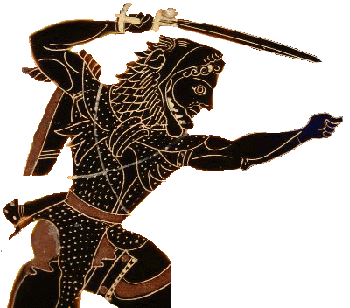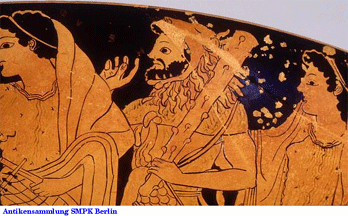 |
“Herakles,” the Greek demigod associated with “Hercules” in Roman mythology, is probably the most revered and known Hero from the classical period. In both the Greek and Roman traditions his cults of believers would make sacrifices to honor this “god.” Today, though sacrifices are no longer made, Hercules is as big as ever, starring in feature films and his own television show.
Herakles was born to Alcmene the wife of Amphitryon, both descendants of Perseus and Andromeda.
Zeus appeared to Alcmene in the shape and appearance of Amphitryon, and shortly after he had left, the real Amphitryon came to Alcmene. Soon two boys were born, one a descendent of Zeus, Herakles, and the other the true son of Amphitryon, Iphicles.
There is a story, that Hera (the wife of Zeus), because of her jealously of the paternity of Herakles, placed two serpents into his crib to kill both baby boys, Herakles and Iphicles, “...but Herakles sat right up and tried his skill at battle for the first time, grasping the two serpents in his strong bare hands and strangling them.”
After witnessing this feat, Amphitryon sent for Zeus’ most eminent prophet, Teiresias. The wise man prophesied to all who were gathered the fortunes the boy would meet, including the number of savage monsters he would kill on land and in the sea. The prophet finished by telling Herakles that after all his great labors he would have as his special prize everlasting peace in the homes of the blessed.
 |
| Berlin F 2278, Attic red figure kylix, c. 500 B.C. Side B: Hercules, carrying his club and wearing his lion skin,walks with a procession of gods and goddesses to Olympus. |
Herakles is best known for the twelve labors that he was bound to complete. Various authors offer different motivations for this journey but seem to agree on the nature of his quest. Apollodorus, in his Bibliotheca II, says that Herakles' counter-part or nemesis was Eurystheus, both were descendents of Perseus.
When the oracle, Apollo, told Herakles, that he would become immortal if he could complete the ten labors set out for him by Eurystheus, the hero set off on his journey....
The first of his labors was to bring Eurystheus the hide of the Nemean Lion, a vicious animal that could not be wounded. Herakles killed the animal by trapping it in a cave and the he strangled it to death. When he returned to Eurystheus with the lion, Eurystheus feared the power and strength of Herakles so much that he forbade him to enter within the city walls.
The second labor was to kill the Hydra of Lerna, which lived in the swamp of Lerna. This creature would often venture into the countryside to feed on livestock and lay waste to the land. The Hydra had an enormous body and nine heads, one of which was immortal. During the battle, whenever Herakles would cut off one of the heads of the Hydra, two would grow back in its place. As if that wasn't difficult enough, a huge crab came to the aid of the Hydra by biting Herakles’ foot. He killed the crab and called for help from his friend and fellow traveler, Lolaus. To trap it, they set fire to the woods around the Hydra. As for the multiplying Hydra heads, they stopped this by burning the stumps on the necks of the Hydra after cutting off a head. Together, the two were able to finally cut off the immortal head and bury it. However, when Herakles returned to Eurystheus, Eurystheus said that this labor did not count because of the aid from Lolaus.
The third labor of Herakles was to bring back the Cerynean Hind of Mycenae alive. This was a deer with horns of gold that was sacred to Artemis (the virgin maiden of hunting). Herakles, after wounding the animal, chased it for a year because he didn't want to kill it and anger Artemis. Finally, he decided to kill it and returned to Eurystheus with the prize.
The fourth labor was to capture the Erymanthian Boar, which was destroying the countryside. When Herakles found the creature, he chased him from its lair out into the snow, covered it with a net and dragged it back to Eurystheus.
The fifth labor was to clean out the enormous stables of Augeas' cattle in one day. He accomplished this feat by diverting the Alpheus and Peneus Rivers into the stables and in exchange Herakles demanded one tenth of the cattle from the king. The water ran out through an opening he had made on the other side and washed the stables. When Herakles returned, Eurytheus did not count this as one of the labors because he was paid in cattle.
Herakles’ sixth labor was to drive off the Stymphalian birds, thesehuge birds had flocked to the Stymphalian swamp to avoid falling prey to wolves. Athena gave Herakles a pair of rattles made by Hesphaestus. Herakles took these rattles to the tops of mountains surrounding the marsh and shook them. The scared birds took off in flight and Herakles shot them with his bow.
The next labor was to bring back the Cretan Bull. The legend was that Poseidon sent the bull to Minos to be sacrificed, but Minos decided to keep the magnificent animal instead. (This is the same bull that Minos’ wife fell in love with the result of their romance, the Minatuar.) Herakles easily caught the Cretan bull and returned it to Eurystheus. He then let the Cretan Bull go, and, it went on a rampage throughout Greece.
For his eighth labor, Eurystheus ordered Herakles to bring the mares of Diomedes of Thrace. Diomedes owned these man-eating horses. After subduing the protectors of the mares, Herakles drove them to the sea and entrusted them to his friend Abderus. Diomedes pursued and Herakles was forced to face the attackers. Upon returning, Herakles discovered that the horses dragged Abderus to his death. He buried his friend and then brought the mares back to Eurystheus, where he let them loose.
The ninth labor Herakles was to perform was to get the warrior’s girdle of Hippolyte, the queen of the Amazons. This girdle was given to her by Ares as a symbol that she was the best warrior among all the Amazons. When Herakles reached the Amazon town of Themiscyra he was greeted by Hippolyte, who promised to give him the girdle. At the same time, Hera, taking the likeness of one of the Amazons told the women warriors that strangers were trying to seize their queen. When Herakles saw the armed women approaching, he thought that Hippolyte had set a trap for him, so he killed her, took the girdle, and returned to Eurystheus.
The tenth labor was to steal the cattle of Geryon. Geryon had the body of three men attached at the hip; so he had six legs and three heads. His famous cattle were red and watched over by a herdsman, Eurytion, and Orthrus, a two-headed dog. Herakles killed Orthrus with his club and then Eurytion when he came to rescue the dog. Geryon hurried to save his cattle, but Herakles brought him down with a single arrow. While returning to Eurystheus, Hera sent a gadfly to disrupt the cattle, causing them to scatter everywhere. Herakles attempted to retrieve them all, but when he couldn’t he returned with the smaller herd.
Herakles’ eleventh labor was to bring back The Golden Apples from the far reaches of the earth. The Apples were given to Zeus by Earth when he was married to Hera. They were guarded by an immortal dragon, which had a hundred heads, and dangerous nymphs called the Hersperides. In searching for the apples, he freed Prometheus from his eternal torture and for this feat Prometheus gave Herakles valuable advice. Prometheus advised him to let Atlas retrieve the apples while Herkacles held up the heavens for Atlas. After Atlas had retrieved the apples, Herakles brought them back to Eurystheus.
Herakles' last labor was to capture Cerebus, the monster that guarded the gates of Hades. This animal had three dog heads, a serpent tail, and the heads of all kinds of snakes on his back. Herakles descended down into Hades and asked Pluto if he could take Cerebus back to Eurystheus. Pluto replied that he could have the monster if Herakles could subdue the animal without the use of weapons. Herakles did, and after showing him to Eurystheus, returned Cerebus to Pluto down in Hades.
There is much debate about the actual death of Herakles, the most famous of which is the story depicted in Euripides’ Women of Trachis. This tragedy tells the story of Herakles’ last wife, Deianeira, whom he saved from marrying a god only after she agreed to marry him. The story begins with Deianeira waiting for her husband to return from some heroic escapade. Upon his return, he brings back prizes from a war he was fighting, one of which was a beautiful young lady. When Deianeira discovers that Herakles plans to marry this new girl, she decides not to be vengeful, but instead accepting. She gave Herakles a special cloak, dipped in the blood of one of Herakles’ foes, thinking that the blood would protect her husband. Instead, it poisoned and severely burned Herakles. It ultimately killed the hero. Upon his death, as promised by Hera he was made a god and lived on Mount Olympus with his father Zeus.
Page created on 4/8/2004 12:00:00 AM
Last edited 1/6/2017 6:41:34 PM
